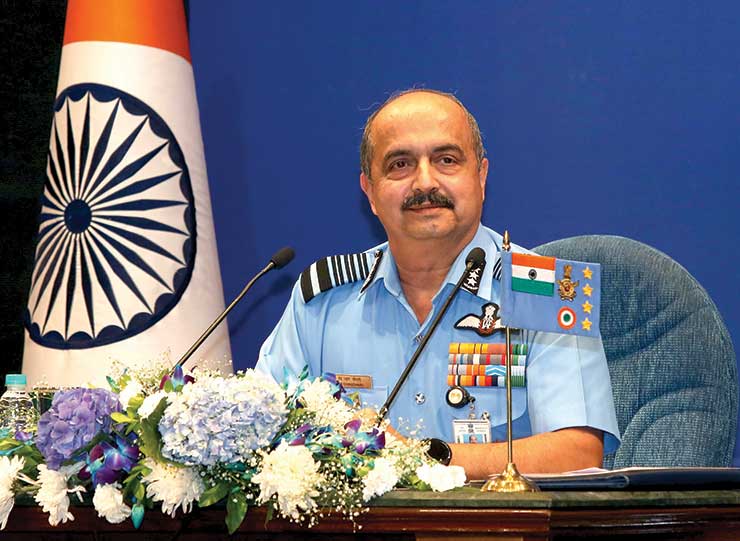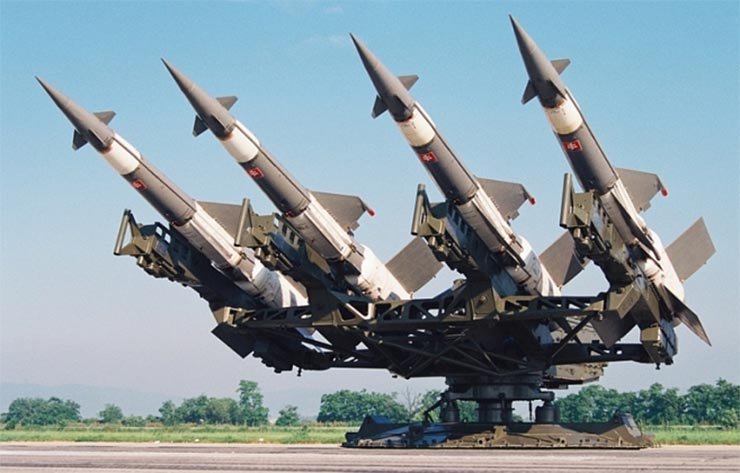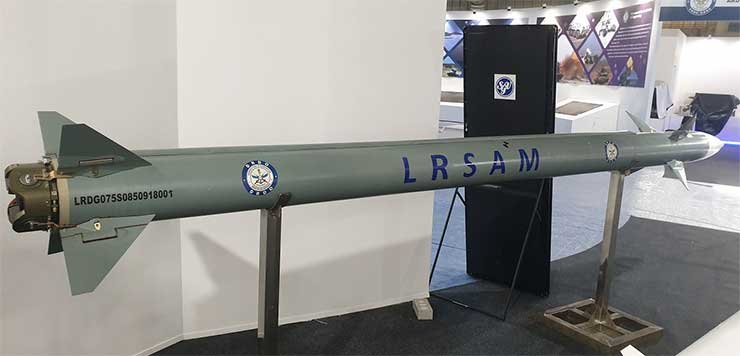
In a move aimed at further boosting the air power even as the exercise to bring the squadron strength of the Indian Air Force (IAF) to 42 to protect the western and northern borders is on, the IAF has decided to have a Weapon System for Officers of the air force which is the first since Independence which would result in a savings of over Rs 3400 crore due to reduced expenditure on flying.
According to reports, with the current pace of induction and retirements, the Indian Air Force can only get a maximum of 35 squadrons in the next 10 years, up from the current 31-32.
The Weapon System Branch for Officers in the IAF will essentially be for manning of four specialised streams of Surface to Surface missiles, Surface to Air Missiles, Remotely Piloted Aircraft and Weapon System Operators in twin and multi crew aircraft, the IAF Chief, Air Chief Marshal V R Chaudhuri said. He said creation of this branch would result in savings of over Rs 3400 crores due to reduced expenditure on flying training.
Ground-based air defence systems play a crucial role in a country’s defence. These are the goalkeepers of the skies. The Indian air force is right now struggling to maintain its squadron strength. In such a scenario the role of air defence systems becomes very important. India is currently developing multi-layer air defence system which would ensure successful interception of incoming aerial threats. India’s multi-layer air defence system would consist of four layers as mentioned below.
Some of the key components of the Indian air defence system which probably would be one of the major components of the Weapons Branch are Long Range interception: Indian Ballistic Missile Defence Programme, Intermediate Interception: S-400 Triumph to be inducted soon, Short Range interception: Akash Air Defence System and Similar Systems and Very Short-range interception: MANPADS and Anti- Aircraft Guns.
The Indian Ballistic Missile Defence Program is an initiative to develop and deploy a multi-layered ballistic missile defence system to protect India from ballistic missile attacks. Introduced in light of the ballistic missile threat from Pakistan, and China, it is a double-tiered system consisting of two land and sea-based interceptor missiles, namely the Prithvi Air Defence (PAD) missile for high altitude interception, and the Advanced Air Defence (AAD) Missile for lower altitude interception. The two-tiered shield should be able to intercept any incoming missile launched from 5,000 kilometres away. The system also includes an overlapping network of early warning and tracking radars, as well as command and control posts.
Prithvi Air Defence (PAD) missile which is an anti-ballistic missile developed to intercept incoming ballistic missiles outside the atmosphere (exo-atmospheric). It has an operational range of 300 km -2000 km. It has maximum interception altitude of 80 km. it is designed to intercept incoming ballistic missiles in their intermediate cruising phase. With a maximum speed over Mach 5, PAD is fast enough to hit intermediate-range ballistic missiles.
It is a two-stage missile. The first stage is a Solid fuelled motor while the second stage is Liquid fuelled. It has manoeuvre thrusters which can generate a lateral acceleration of more than 5 gs at 50 km (31 mi) altitude. Guidance is provided by an inertial navigation system with mid-course updates from LRTR and active radar homing in the terminal phase. LRTR is the target acquisition and fire control radar for the PAD missile. It is an active phased array radar having the capability to track 200 targets at a range of 600 km
The first test was conducted in 2006 in which a PAD missile successfully intercepted a modified Prithvi-II Missile at an altitude of 50 km. The Prithvi-II ballistic missile was modified successfully to mimic the trajectory of M-11 missiles.
Another important weapon is the Advanced Air Defence (AAD) Missile which is an anti-ballistic missile designed to intercept incoming ballistic missiles in the endo-atmosphere at an altitude of 30 km (19 mi). It is for those targets which somehow get passed through PAD. It is a secondary layer which compliments PAD.
AAD has an operational range of 150 km to 200 km. It has a maximum speed of Mach 4.5. AAD is a single-stage, solid-fuelled missile with siliconised carbon jet vanes. Guidance is similar to that of PAD with indigenous radio frequency seeker. It supports the inertial navigation system (INS), mid-course updates from ground-based radar and active radar homing in the terminal phase.
Then there is the Short Range interception (less than 100 km) which the Indian Army and Indian Air force operates a variety of systems in this segment. These mainly include Surface to Air Missiles (SAM) like Akash SAM, S-125 Pechora, Spyder Air defence system.
S-125 Pechora is a surface to air missile system of Soviet origin. For a very long time, this system has been the backbone of Indian Air Force’s Air defence. This system is 60 years old as it was first inducted into service by the Soviet Union in 1961. This system has participated in almost every modern conflict. It has countless kills against various adversaries. IAF operates 25 squadrons of Pechora.

Akash is a medium-range mobile surface-to-air missile defence system developed by the Defence Research and Development Organisation (DRDO) and the missiles produced by Bharat Dynamics Limited.
The missile system can target aircraft up to 45 km away, at altitudes up to 18,000 m. It has the capability to neutralize aerial targets like fighter jets, cruise missiles and air-to-surface missiles as well as ballistic missiles.
An Akash battery comprises a single Rajendra 3D passive electronically scanned array radar and four launchers with three missiles each, all of which are interlinked. Each battery can track up to 64 targets and attack up to 12 of them. It has a war head with 60 kg pre-fragmented high explosive war head with an operational range of 45 kms.
Indian Air force operates 8 squadrons of Akash air defence system. Indian Amy operates 2 regiments of it. Army has also placed order for 2 more regiments.
The SPYDER (Surface-to-Air Python and Derby) is an Israeli short and medium-range mobile air defence system developed by Rafael Advanced Defence Systems with assistance from Israel Aerospace Industries (IAI).
The SPYDER is a low-level, quick-reaction surface-to-air missile system capable of engaging aircraft, helicopters, unmanned air vehicles, drones, and precision-guided munitions. It provides air defence for fixed assets and for point and area defence for mobile forces in combat areas.
The SPYDER launcher is designed to fire Python-5 and Derby surface-to-air missiles which share full commonality with the air-to-air missiles. There are two variants of the SPYDER: the SPYDER-SR (short range) and the SPYDER-MR (medium range). Both systems are quick reaction, all weather, network-centric, multi-launchers, and self-propelled.
A typical battery consists of one central command and control unit, six missile firing units, and a resupply vehicle. The SPYDER-SR uses the EL/M-2106 ATAR radar while the SPYDER-MR incorporates the EL/M-2084 MMR radar. The latter is the same radar used by the Iron Dome system currently in service with the Israel Defense Forces.
IAF currently operates a single squadron of SPYDER and has placed order for 4 more squadrons.
The 9K33 Osa is a highly mobile, low-altitude, short-range tactical surface-to-air missile system designed in the Soviet Union. Osa was the first mobile air defence missile system incorporating its own engagement radars on a single vehicle. All versions of the 9K33 feature all-in-one 9A33 transporter-launcher and radar vehicles which can detect, track and engage aircraft independently or with the aid of regimental surveillance radars. The six-wheeled transport vehicles BAZ-5937 are fully amphibious and air transportable. The road range is about 500 km.
The Osa Ak system used by IAF carries 6 9M33M3 missiles with an approximate range of 15 km and maximum speed of Mach 3.
1S51M3 (“Land Roll”) – C band target acquisition radar, H band conical scan target tracking radar and two J band pulse mode fire control radars (range 35 km/22 miles for acquisition, 30 km/19 miles for tracking and 25 km/16 miles for guidance). Mounted on the TELAR.
P-40 (“Long Track”) – E band early warning radar (range 175 km/108 miles), mounted on a tracked vehicle. P-15 – 380 kW C band target acquisition radar (range 250 km/155 miles), mounted on a ZiL-131 truck. PRV-9 – E band height finding radar ( range 240 km/148 miles), mounted on a KrAZ-255B truck.
The 2K12 “Kub” mobile surface-to-air missile system is a Soviet low to medium-level air defence system designed to protect ground forces from air attack.
Each 2K12 battery consists of a number of similar tracked vehicles, one of which carries the 1S91 25 kW G/H band radar (with a range of 75 km) equipped with a continuous wave illuminator, in addition to an optical sight. The battery usually also includes four triple-missile transporter erector launchers (TELs), and four trucks, each carrying three spare missiles and a crane. The TEL is based on a GM-578 chassis, while the 1S91 radar vehicle is based on a GM-568 chassis, all developed and produced by MMZ.

Barak 8 also known as LR-SAM or as MR-SAM is an Indo-Israeli surface-to-air missile (SAM), designed to defend against any type of airborne threat including aircraft, helicopters, anti-ship missiles, and UAVs as well as ballistic missiles, cruise missiles and combat jets.
Barak 8 was jointly developed by Israel Aerospace Industries (IAI), India’s Defence Research & Development Organisation (DRDO), Israel’s Administration for the Development of Weapons and Technological Infrastructure, ELTA Systems, Rafael and other companies. Bharat Dynamics Limited (BDL) produces the missiles.
Quick Reaction Surface-to-Air Missile (QRSAM) is a missile developed by the DRDO in association with Bharat Electronics Limited and Bharat Dynamics Limited for the Indian Army. This missile is an all-weather, all-terrain SAM equipped with electronic countermeasures against jamming by aircraft radars. The missile can be mounted on a truck and is stored in a canister. QRSAM uses solid-fuel propellant and has a range of 25–30 km. The single-staged missile uses solid propellants for propulsion. The missile is equipped with a midcourse inertial navigation system with a two-way data link and a DRDO-developed terminal active seeker. The system has the capability to search and track targets while moving
QRSAM is a compact weapon system and is mobile. It has a fully automated Command and Control System. The missile system comprises two four-walled radars both of which encompass a 360-degree coverage, namely, the Active Array Battery Surveillance Radar and the Active Array Battery Multifunction Radar, apart from the launcher.
The SA-5 Gammon (Russian name S-200 Angara/Vega) is a low- to high-altitude very long-range surface-to-air missile system designed to defend large areas from bomber attack or other strategic aircraft. Initial deployment of an S-200 trials unit using the original 5V21 missile took place from 1963 to 1964 on the outskirts of Tallinn in Estonia. The first operational regiments were deployed in 1966 with 18 sites and 342 launchers in service by the end of the year.
In 1989, India purchased two S-200 Angara systems and 24 5V21 missiles from the Soviet Union. Today, the S-200 augments India’s lower altitude air defences as the country pursues more advanced ballistic missile defence capabilities, such as its Prithvi Air Defense (PAD) and Advanced Air Defense (AAD) missile interceptors.
With the advent of drones, swarm drones, hypersonic weapons and space based ISR systems adding a new dimension to war fighting the new weapons branch is bound to add more firepower to the air force and give the necessary boost to the IAF till such time it acquires its full squadron strength.









